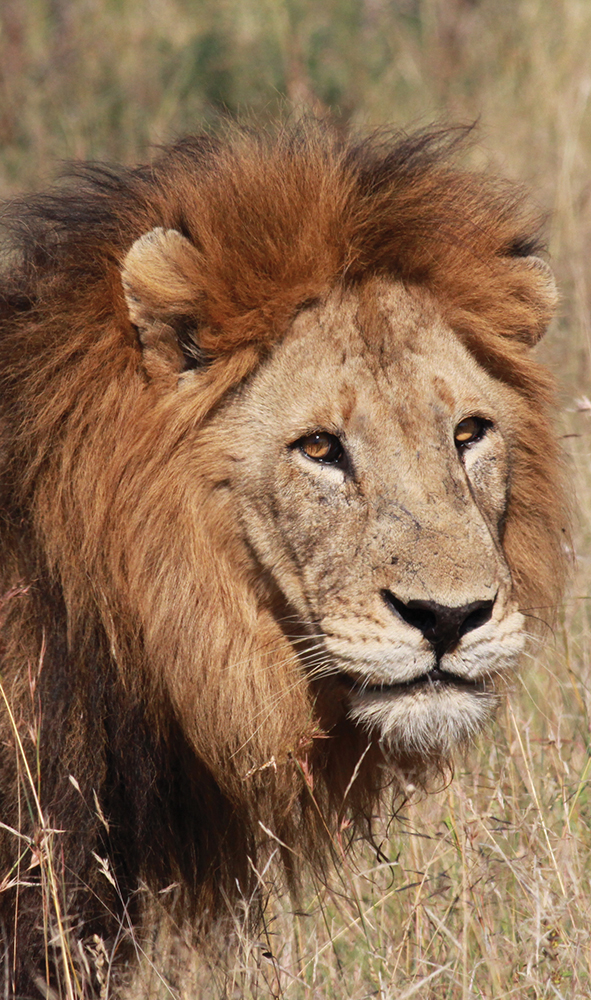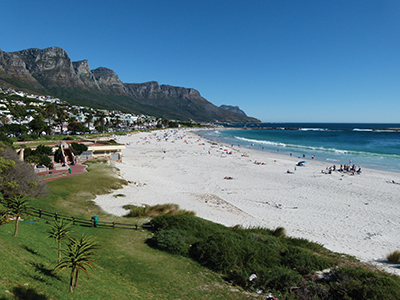
Camps Bay, Cape Town.
I KEPT THINKING — shortly after I stumbled in the dark upon a 13,000-pound bull elephant blocking the entrance to my private bungalow — of the lyric Eva Gabor sings in the opening credits for the TV show Green Acres, “Dahling I love you but give me Park Avenue.”
And that is South Africa in a nutshell: the original town and country. One day you’re sipping a minty mojito at a Cape Town beach side cafe, and the next you’re deep in the bushveld, watching a leopard dine on the same wild game you had for dinner last night.
Chances are most of us will only have one opportunity to go on a safari, yet there are more than 2,300 safari tours to choose from within eight African countries: from gorilla trekking in Uganda to birding safaris in Botswana. But only in South Africa can you easily combine both a cosmopolitan vacation experience touring Cape Town and its surrounding wine regions with an exhilarating big-game safari in the wild.
Granted, driving through South Africa’s Kruger National Park doesn’t feel as wild as tearing across Tanzania’s Serengeti with a Masai warrior in the backseat, but the animals you’ll see — and see them you will — aren’t any less feral, beautiful and dangerous. If you’re OK with that, and wiggling your toes in warm Cape Town sand in February sounds just fine, then dahling it’s South Africa for you.
It’s Who You Know
It was my third trip to Johannesburg’s Tambo International Airport — Africa’s equivalent of Heathrow — but this time it wasn’t to take a connecting flight to another country. I gave myself three weeks to explore as much of South Africa as possible, and the adventure started before I even left the international terminal.
Following a man with my name on a sign, I was led to a coffee bar — by the way, the coffee in Africa is first-rate — and introduced to a clean-cut gentleman in his late 20s who looked a bit like Justin Timberlake. “Hello, Matthew,” he said in that distinctive South African accent. “I’m Guy. Welcome to South Africa.”
Guy Ellis is a native South African who heads up a leopard identification database effort throughout South Africa used to track, census and plot home ranges for these endangered cats. He also runs his own luxury safari company serving Cape Town, Johannesburg, Stellenbosch and wherever else you wish to travel in his country.
Fun in Town
As much as I abhor clichés, there really is something for everyone in South Africa. I came for adventure, and within 24 hours of my arrival Guy had arranged rock climbing, ATV quad 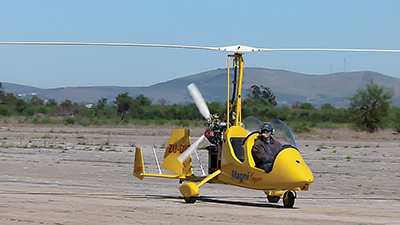 biking, tandem paragliding, mountain biking, rappelling down Table Mountain (a 400-foot sheer drop), great white shark diving and — even more insane than shark diving — a wild ride in a gyrocopter. (Kitesurfing, bungee jumping, skydiving, big game fishing, surfing and stand-up paddleboarding are also popular activities in the region.)
biking, tandem paragliding, mountain biking, rappelling down Table Mountain (a 400-foot sheer drop), great white shark diving and — even more insane than shark diving — a wild ride in a gyrocopter. (Kitesurfing, bungee jumping, skydiving, big game fishing, surfing and stand-up paddleboarding are also popular activities in the region.)
When I wasn’t assuaging my midlife crisis with adventure sports, I was at the beach. Cape Town’s beaches, set against the dramatic backdrop of Table Mountain, are its finest asset: pristine, golden and never more than a short walk to nearby cafes for lunch and cocktails, where service is always cheerful and the bill surprisingly low. I came to think of it as the Santa Monica of South Africa, and I could have easily stayed all summer.
If I had more time I would have spent a few days exploring South Africa’s equivalent of the Napa Valley: Stellenbosch. Located a short drive from Cape Town, it’s the country’s most popular wine region and home to some spectacular wine estates (which I viewed via gyrocopter). The New World wines emerging from the Western Cape of South Africa are increasingly popular and quite affordable — particularly South Africa’s own earthy varietal, Pinotage — and wine tasting tours are one of Cape Town’s most popular excursions.
Adventure in the Country
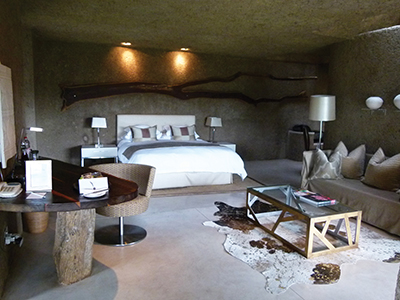
Sabi Sabi Earth Lodge.
With the “town” part of my visit completed, it was time for the “country.” Before my departure to South Africa I had arranged a stay at one of the most luxurious and respected safari lodges in the country: Sabi Sabi, a private game reserve in the southwestern section of Kruger National Park. Sabi Sabi consists of four completely separate lodges, each with its own distinct location, character and atmosphere.
If there was room for improvement at their Earth Lodge I couldn’t find it. I stay in hotels for a living and here was one of the finest ones I’ve visited, in the middle of seemingly nowhere. If sleeping in a tent — however glamorous it may be — in a wild game park isn’t your cup of tea, stay here instead: Each private suite has all the modern comforts of home, including air-conditioning, sliding glass doors, private pools and walls a foot thick. Breakfast, lunch and dinner, included in the rate, are prepared by an on-site chef who excels at utilizing locally harvested vegetables, fruits and meats.
On par with the quality of Sabi Sabi’s lodging and service are its private safaris. My personal safari guide, Joe Mashaba, is one of the most likable people I’ve ever met. His ability to spot creatures great and small was astounding: chameleons, rhinos, kudus, giraffe, lions, leopards, hyenas and even centipedes, spiders and beetles. He was always just as excited to spot animals as we were, and you could tell he had a great fondness for every plant and animal within the reserve. If you do visit Sabi Sabi, request Joe as your guide, and tell him I said kunjani (Shangaan for “howdy”).
A Unique Experience
From Sabi Sabi, Guy arranged a private flight to the Tintswalo safari lodge on the eastern boundary of Kruger National Park. Upon arriving, I asked where the other guests were. “There are no other guests; this lodge is yours. As are the staff, chef, ranger, tracker, vehicles and most of this 27,500-hectare reserve. We all are here to fulfill whatever it is you wish to do. As long as it isn’t illegal or too dangerous.”
As a journalist, I had been on five safaris before I met Guy, but I had never been allowed to exit a safari vehicle and track animals on foot. So we did. In the morning our tracker, Mpho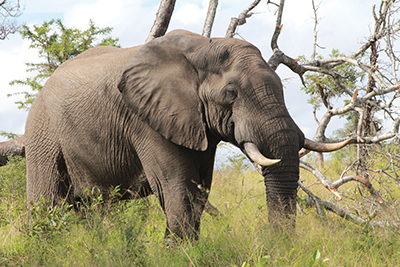 (pronounced mmm-PO), taught me how to recognize lions’ tracks, and within an hour of spotting and following fresh lion prints we were crawling as close to the pride as our ranger, Fritz, would allow. We were within 100 feet of the lions, yet a mile away from the safety of our vehicle. It was one of the most thrilling things I’ve ever done. The next day we tracked rhinos on foot — another heart pounding experience — then after dinner I was treated to a very rare nocturnal safari to watch a pride of lions hunt, witness a leopard feeding, and see all manner of exotic creatures of the night.
(pronounced mmm-PO), taught me how to recognize lions’ tracks, and within an hour of spotting and following fresh lion prints we were crawling as close to the pride as our ranger, Fritz, would allow. We were within 100 feet of the lions, yet a mile away from the safety of our vehicle. It was one of the most thrilling things I’ve ever done. The next day we tracked rhinos on foot — another heart pounding experience — then after dinner I was treated to a very rare nocturnal safari to watch a pride of lions hunt, witness a leopard feeding, and see all manner of exotic creatures of the night.
The next day was spent with Grant Beverly of the Endangered Wildlife Trust, one of the world’s top experts on African wild dogs, assisting him with tracking, calling and identifying these highly endangered animals. It was a National Geographic–like moment that few people on this planet will ever experience. Then again, pretty much this entire safari was like being in a television special.
If You Go
AIRLINES The majority of tourists who come to South Africa typically schedule a visit to Cape Town on the west coast, followed by a safari in South Africa’s Limpopo Province, which includes Kruger National Park, the Yellowstone of South Africa. Numerous airline charter companies offer connecting flights between Jo’burg’s International Airport, Cape Town, and the regional airports and airstrips that connect to nearby safari lodges. All charter flights, transfers and airport express butlers (worth every penny) can be booked before you depart through The Premier Pass at thepremierpass.com. If you only have 10 to 14 days of vacation time, I suggest splitting your time between Cape Town and a safari and prearranging three connecting charter flights: Jo’burg to Cape Town, Cape Town to the recommended airstrip near your safari lodge (ideally a direct flight and not connecting through Jo’burg), and a final flight back to O.R. Tambo International (JNB). South Africa is too vast to comfortably drive, and the train system is more quixotic than practical. As for the flight from the States to South Africa and back, I highly recommend the 16-hour direct flight from JFK to JNB on South African Airlines. The airline also has one of the best business-class services I’ve experienced (my in-fight meal was superb — herbed lamb chops atop a rosemary demi-glace served with potato au gratin, sautéed spinach and a glass of Bordeaux-style Anthonij Rupert Optima from Franschhoek Valley in South Africa’s Western Cape).
CELLPHONE If you’re only going on safari, you won’t necessarily need a cellphone. Otherwise you’ll definitely need a cellphone, if only for calling a cab. You can rent a basic cellphone when you arrive at O.R. Tambo International for a few dollars per day, including a service plan, but I strongly recommend you have your current smartphone unlocked before you depart and prepurchase a voice+data SIM card online via b4i.travel, which you can pick up at your arriving airport (make sure to test it before you depart the kiosk). This way you can use all of your travel apps (including Google Maps) on a phone that you’re familiar with, and you’ll already know your SIM’s phone number in South Africa before you depart — a major convenience.
GETTING AROUND Cape Town is small enough to explore on foot during the day and has a very modern public bus system that uses a debit card–style payment system. Otherwise I recommend using an established cab company such as CabCo (cabco.co.za) and getting the name and cell number of your driver, then making all your future transportation arrangements with him. While renting a car to explore outside Cape Town is a popular option, I suggest hiring a driver through The Premier Pass (thepremierpass.com). The cost is minimal, and if you’re not used to driving on the opposite side of the road, it could save your life.
SAFETY The biggest complaint I’ve heard from people who have traveled to Cape Town had to do with a concern for their safety, particularly at night. If you don’t feel comfortable walking through the city at night, use your cellphone to call your cab service, even if you’re going just a short distance. A familiar cab driver quickly becomes your new best friend in a foreign city.
LODGING You may think I’m crazy for recommending this, but even the locals say it’s the way to go in Cape Town: airbnb.com. After less than an hour online I rented a furnished flat just two blocks from the beach. The majority of apartment and condo units in popular Cape Town tourist destinations are now rented solely via the service. For safari lodging, I recommend booking your trips through Completely Unique Safaris (completelyuniquesafaris.com) or Sabi Sabi Luxury Safaris (sabisabi.com).
DINING You would think a seaside city such as Cape Town would have great seafood, but it doesn’t. The “best” sushi restaurant I went to only served salmon and tuna. Nonetheless, Cape Town has a vibrant dining scene, and locals love to eat out. Recommended restaurants include Gold Restaurant for authentic African (goldrestaurant.co.za; be sure to make a reservation); a fantastic steak house called Carne (carne-sa.com); Tamboers Winkel for free-range rotisserie chicken, bobotie and salads; and The Bungalow for romantic seaside alfresco dining (thebungalow.co.za). Service is typically quite good, and tipping is the same as in the states — 15 to 20 percent.
MONEY You’ll be surprised how far your dollar goes in South Africa. A steak dinner with wine shouldn’t cost more than $10, and cab fare is usually less than $5 per trip. The South African rand is roughly R10 to the U.S. dollar and is the preferred monetary unit for cash transactions. Credit and debit cards are accepted just about everywhere, but avoid using third-party ATMs — some are set up to steal your account and PIN number.
HEALTH Ask five different people whether you should take malaria medication for your South Africa safari and you’ll get five different answers. I stopped taking Malarone after my first safari in Kenya when I realized that none of the locals took it. “Just don’t get bit,” they say. I had a family friend who started taking her malaria meds the day before she left New York and was hallucinating at the airport and had to cancel her $10,000 prepaid trip. One local I met swears by Nordman Anti-Malaria Artemisia tablets. Everyone recommends mosquito repellent, long-sleeve shirts and long pants. Cape Town is malaria-free. When in doubt as to what meds and shots are needed, visit cdc.gov/travel. As for Ebola: As of the print date there have been no cases of Ebola in South Africa; nevertheless, local tourism has taken a big hit.
CLOTHING For safaris they say to wear neutral-colored clothing so you don’t spook the animals, but I felt like I could have been wearing a sequin dress and the animals wouldn’t have noticed. And yes, you can spend $80 on a smashing Tilley hat, but all the guides and rangers just wear greenish-khaki baseball caps, pants and long-sleeve shirts. In Cape Town anything goes except formal wear (fashion-forward the place ain’t).
MUST-HAVE SAFARI ITEMS The best binoculars you can afford (I use Leopold BX-2 Cascades 10×42 and even the guides were impressed), with a suspender-style harness. The best camera with HD video and fastest camera lens you can afford (and turn off that damn beeping sound). The fastest memory cards available, such as SanDisk Extreme Pro SDXC 64GB, and twice as much memory as you think you’ll need. A small backpack to bring on the safari vehicle. Very good bug repellent, such as Ultrathon Insect Repellent by 3M.
LANGUAGE I agree: it’s usually polite to learn how to at least say “Thank you” in the local dialect of the country you’re visiting, but South Africa has 11 official languages, so good luck with that. In the tourist regions of South Africa nearly everyone speaks English, and the four other languages you’re likely to overhear are Afrikaans, Zulu, Xhosa and Sotho. Your biggest language challenge will be understanding your cab driver.

